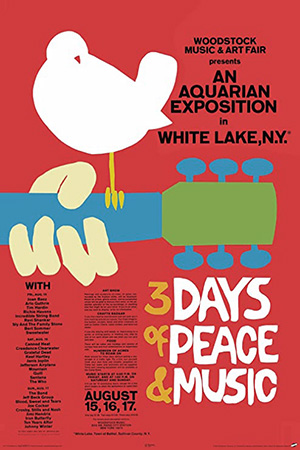
The Woodstock Music and Art Festival was a rock music festival at Max Yasgur’s 600 acre (2.4 km²) dairy farm in the town of Bethel, New York from 15–18 August 1969. It might be the most famous rock concert and festival ever held. For many, it showed the counterculture of the 1960s and the «hippie era».
The festival was called «Woodstock», because the investment group that backed the concert was called «Woodstock Ventures.» It was originally planned for Saugerties, and then the Town of Wallkill, in Orange County (not to be confused with the Hamlet of Wallkill, in Ulster county). People in the Town of Wallkill, meaning those on the Town Board, quickly passed a law that required a permit to hold any gathering for over 5,000 people. A permit was applied for, but it was denied because the portable toilets proposed were considered to be inadequate. A Sullivan County farmer named Max Yasgur heard about the festival and the problems and offered his farm in the Town of Bethel. He was paid $10,000 for the three days.
Although all the municipalities were told there would be no more than 50,000, the organizers thought they would get as many as 150,000, and by best counts, there were more than three times that number over the three days. Most did not pay to get in, and the festival lost money as a result. The roads to the concert were jammed with traffic. People left their cars and walked for miles to get to the concert area. The weekend was rainy and overcrowded, and fans shared food, alcoholic drinks, and drugs. Some people who lived there, including those at nearby Camp Ma-Ho-Ge, gave blankets and food to some concert-goers.
After two days of rain, there was deep mud in many places. There was almost no water for washing, and not enough toilets. Many of the concert-goers had brought small tents to sleep in; some of these turned into piles of cloth and mud. Even though this may not have been the most comfortable place, the crowd kept up kindness and good cheer among themselves. As the half-million people in the audience became aware of this, a warm feeling of friendship spread to everyone.
We use cookies on our website to provide you with the most relevant experience by remembering your preferences and repeat visits. By clicking "I Accept", you agree to the use of all cookies. Read more
Cookie SettingsReject AllI Accept
| Cookie | Duración | Descripción |
|---|---|---|
| cookielawinfo-checkbox-analytics | 11 months | This cookie is set by GDPR Cookie Consent plugin. The cookie is used to store the user consent for the cookies in the category "Analytics". |
| cookielawinfo-checkbox-functional | 11 months | The cookie is set by GDPR cookie consent to record the user consent for the cookies in the category "Functional". |
| cookielawinfo-checkbox-necessary | 11 months | This cookie is set by GDPR Cookie Consent plugin. The cookies is used to store the user consent for the cookies in the category "Necessary". |
| cookielawinfo-checkbox-others | 11 months | This cookie is set by GDPR Cookie Consent plugin. The cookie is used to store the user consent for the cookies in the category "Other. |
| cookielawinfo-checkbox-performance | 11 months | This cookie is set by GDPR Cookie Consent plugin. The cookie is used to store the user consent for the cookies in the category "Performance". |
| viewed_cookie_policy | 11 months | The cookie is set by the GDPR Cookie Consent plugin and is used to store whether or not user has consented to the use of cookies. It does not store any personal data. |